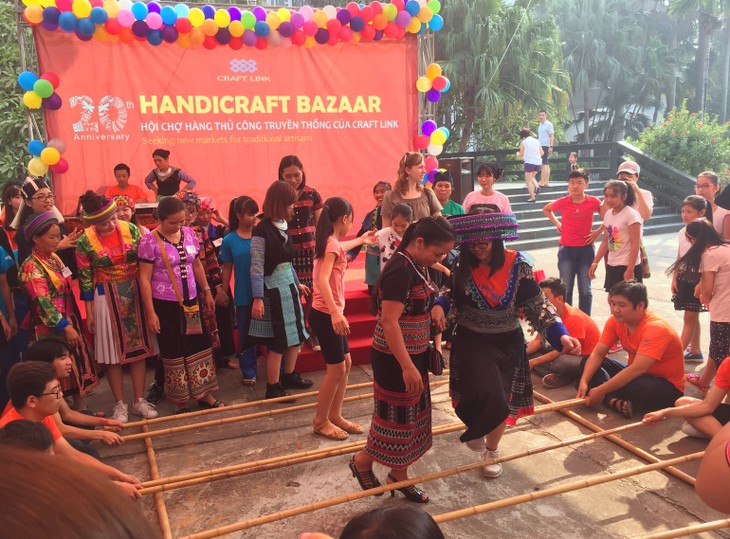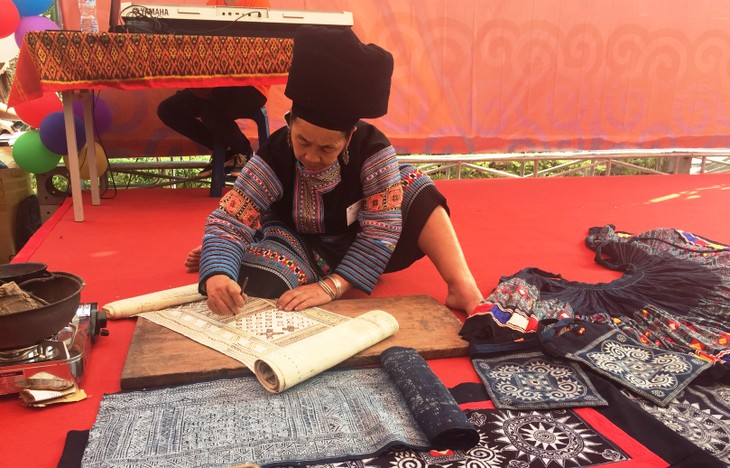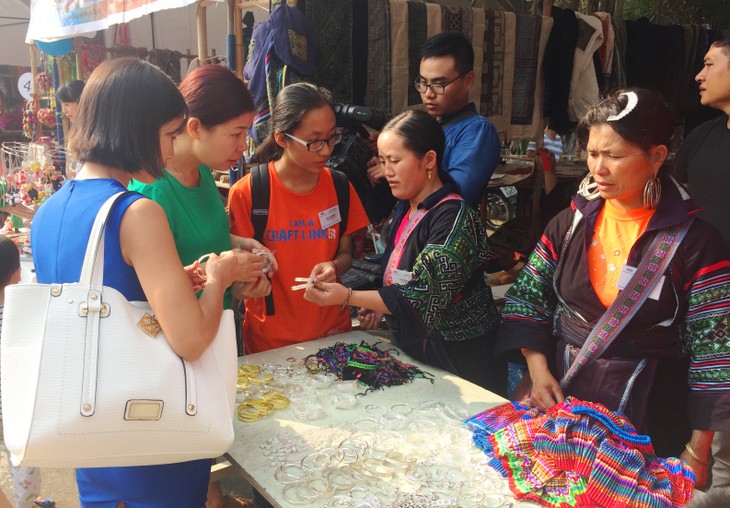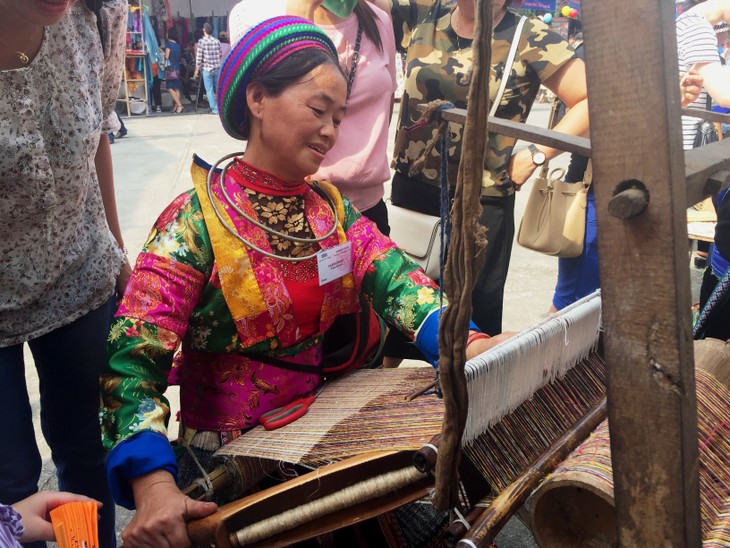(VOVworld) – Every year in November, the Center for Handicraft Research, Linkage and Development (Craft Link) holds a bazaar to showcase the traditional handmade products of a range of ethnic groups to consumers in Hanoi. The event aims to help minority people preserve their culture and improve their livelihoods through production and marketing.
 |
The joyful bamboo dancing caught the attention of many bazaars goers (Photo: VOV/Dieu Ha)
|
In the wide front yard of the Vietnam Museum of Ethnology, children were happily engaged into bamboo dancing. With quick instructions from ladies in beautiful brocade dresses, they tried to move their feet quickly between bamboo sticks, which were controlled in synch by other people. Though some children were caught, they did not seem to really mind failing and were more eager to restart the joyful dance.
“I like the dance very much. I was caught once but it was okay. It did not hurt at all. There was a sister helping me do the bamboo dance. I’ve learnt that the dance is from the northern mountainous region of Vietnam”said Vu Bich Ngoc, a middle-school student from Hanoi.
 |
An artisan of the White Mong ethnic group showed how to decorate dresses using the traditional hot bee wax (Photo: VOV/Dieu Ha)
|
The interactive bamboo dance, along with other games such as tug of war and quick puzzles were all part of a day-long event hosted by the Center for Handicraft Research, Linkage and Development (Craft Link) to introduce the culture and traditional handicraft products of ethnic minorities to people in Hanoi. Vietnamese and foreign visitors had a chance to sample products from 44 ethnic groups, craft villages and disadvantaged groups across Vietnam. With diverse items ranging from brocade clothes to bamboo baskets, jewelries, children toys and house decorations, many Hanoi citizens and foreign expats found this November pop-up market an ideal place to shop for Christmas.
“I just bought some cushion covers for my house and to give to my family members as Christmas gifts. I was impressed by the variety and beauty of different cultural groups you have here”, said David Salewski from Germany.
 |
Children were especially attracted to handmade toys (Photo: VOV/Dieu Ha)
|
Sarah Garner from the US came to work for an NGO in Hanoi a few years ago. She has never missed any of the Craft Link bazaars. “I think the bazaar is increasingly better organized but the prices are going up a lot. It’s okay because compared to Laos or Cambodia, the fabric is always very expensive. In Vietnam it’s always very cheap. So I think now the Vietnamese minorities know how special their things are and ask for more money, which is a good thing. I’m also happy to see more and more Vietnamese people coming to the bazaar because the first time I was here, there were mostly foreigners”, said Garner.
This was the 20th handicraft bazaar hosted by Craft Link. Ms. Tran Tuyet Lan, General Manager of the organization could not hide her pride as the event attracted more and more visitors year after year:“We believe this is the best opportunity for visitors to learn about the culture of ethnic groups because they can interact directly with local people. After this event, ethnic people can earn more customers and learn more about their consumers’ preferences so they can adjust their products. On the other hand, visitors to this event can also learn about the culture of the many ethnic groups across Vietnam.”
 |
Vietnamese and foreign visitors had a chance to sample products from 44 ethnic groups, craft villages and disadvantaged groups across Vietnam (Photo: VOV/Dieu Ha)
|
All the products presented at the Saturday bazaar were produced as part of a program run by Craft Link, which helps at small Vietnamese craft producers to develop their businesses and find market opportunities, while still abiding by fair and sustainable trade standards. This means minority producers follow the rules of gender payment equity, child labor prevention, and safe and healthy working conditions.
“Over the past 20 years, we have consistently assisted 70 ethnic minority group, disabled groups and traditional craft villages across Vietnam, to revive their traditional cultures and improve their income for community development. First, we help them organize production groups and provide training so that they can operate on their own. We also assist in product design, product finalization and marketing. After two years of training, products made by minority people can be exported to international markets”, Craft Link General Manager Tran Tuyet Lan elaborated.
After each bazaar, Craft Link continues to maintain a close relationship with the artisans they have worked with. People who may have never left their villages in their whole lives are now able to go to other cities, market their products, and talk about their culture like at the November pop-up market in Hanoi. Ms. Lan said: “Craft Link supports over 6,000 beneficiaries in Vietnam. Their incomes have also improved a lot. In many cases, the earnings from making traditional craft products are much higher than their earnings from farming and raising cattle.”
 |
Tran Thi Da happily introduced her products to visitors (Photo: VOV/Dieu Ha)
|
Tran Thi Da from Sa Pa, Lao Cai appreciated all the help from the people at Craft Link: “Today we bought embroidered paintings, brocade products such as backpacks and dresses and traditional silver jewelry. These are products that represent our own identities. We thank Craft Link for helping us introduce our products to consumers in Hanoi and increase our income”.
 |
A representative of the Mong ethnic group in Ha Giang province showed viewers how to weave traditional linen clothes (Photo: VOV/Dieu Ha)
|
With the same appreciation, Ly Thi Dinh, who represented the Mong ethnic group in Ha Giang province at the bazaar, said:“I hope that Craft Link will continue to hold handicraft bazaars like this so that we can have more opportunities to sell our products and gain more support from people.”
Dieu Ha